
Carissa Moore ’10 brings Olympic glory home to Hawai‘i
BY SHANNON WIANECKI
Related: Punahou’s Storied Surfing Legacy
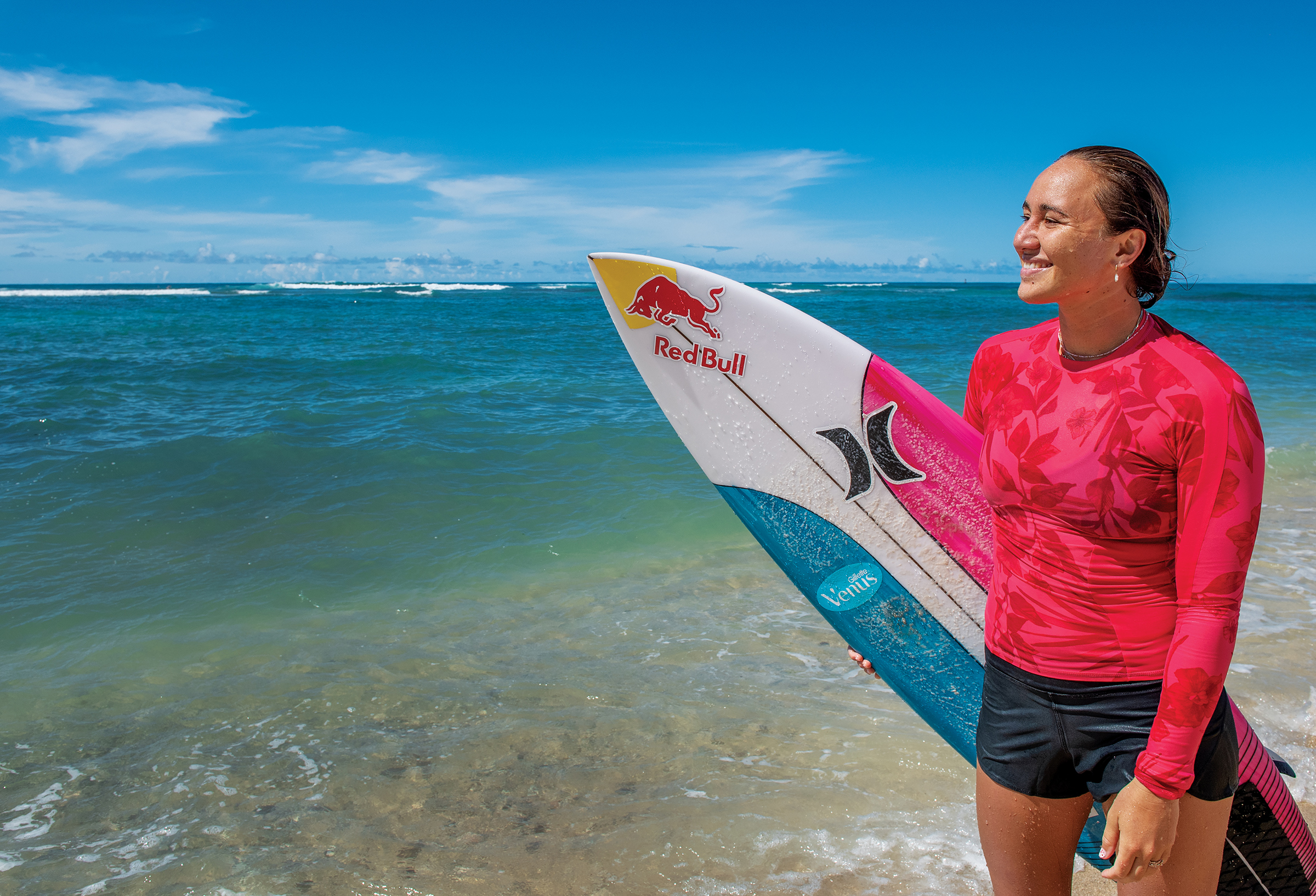
Storm clouds hung over Japan’s Tsurigasaki Beach on the final day of the first-ever Olympic surf competition. By that late July afternoon, 20 of the world’s best female surfers had been whittled down to just two – South Africa’s Bianca Buitendag and Hawai‘i’s Carissa Moore ’10. The short, choppy waves didn’t give them much to work with, but midway through their gold medal match, a rainbow appeared on the horizon. A hō‘ailona – or sign – as those from Hawai‘i would note.
Buitendag couldn’t catch up to Moore, who managed to squeeze magic out of the mediocre surf. Powering into her last wave, Moore snapped across the lip to drop into the tumbling whitewash, her Hawaiian heirloom bracelets glittering against the grey sky. As she shot through a surge of sea foam twice her height, the speakers broadcast the final score: “Gold goes to Hawai‘i, where surfing began!” Moore’s face crumpled into tears. She blew a kiss to the crowd, and then charged into one last celebratory wave just for fun.
After her historic win, Moore became a global household name – a triumph for surfing, for women athletes and for Hawai‘i. People linked her to Duke Kahanamoku, Hawai‘i’s first Olympian and the father of modern surfing. Kahanamoku won his first of five medals for swimming at the 1912 Olympics in Stockholm. A lifelong ambassador for surfing, he advocated for the sport’s inclusion in the games.
Now, more than 100 years later, another Native Hawaiian helped fulfill his wish. When Moore brought the gold medal home to surfing’s birthplace, social media went bananas. “Tears were falling watching this Native Hawaiian woman take gold,” wrote one of thousands of commentors on the video of her win. Another said: “Only fitting a kanaka wahine show them how it’s done.”
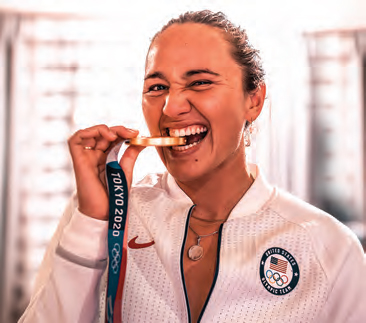
Kūhiō Lewis, president of the Council for Native Hawaiian Advancement, told the Associated Press that Carissa’s win was a “reclaiming” of the sport for the Native Hawaiian community – a “come-to-home moment.”
Even for Moore, who at age 29 has captured nearly every major surfing title, qualifying for the Olympics was a thrill. “I’m super proud to be Hawaiian and to be able to travel to the Olympics and represent not only the United States, but the Hawaiian Islands and the community that I’ve grown up with,” she says.
The comparison to Kahanamoku humbles her. “It’s flattering that people even mention me in the same sentence as Duke. I look up to him so much for inspiration – not only for his achievements, but how he treated people. It’s an honor to be a small part of his story and his dream.”
After the Olympic whirlwind, Moore returned to her home break in Honolulu. One early morning, she and her father, Chris Moore, hiked down the sloping path to Diamond Head Beach, boards tucked under their arms. A small audience watched from the cliff as Carissa pivoted effortlessly on each wave in a bright red rash guard. She’s a commanding force in the water, blending old-school grace with powerful athleticism. She can drive her board anywhere she wants on a wave, and her toes have a seemingly magnetic grip.
After she paddled back to the beach, a fellow surfer stopped to congratulate her – one of the many locals she’s surfed side-by-side with since her small kid days. She smiled and humbly thanked him for the support.
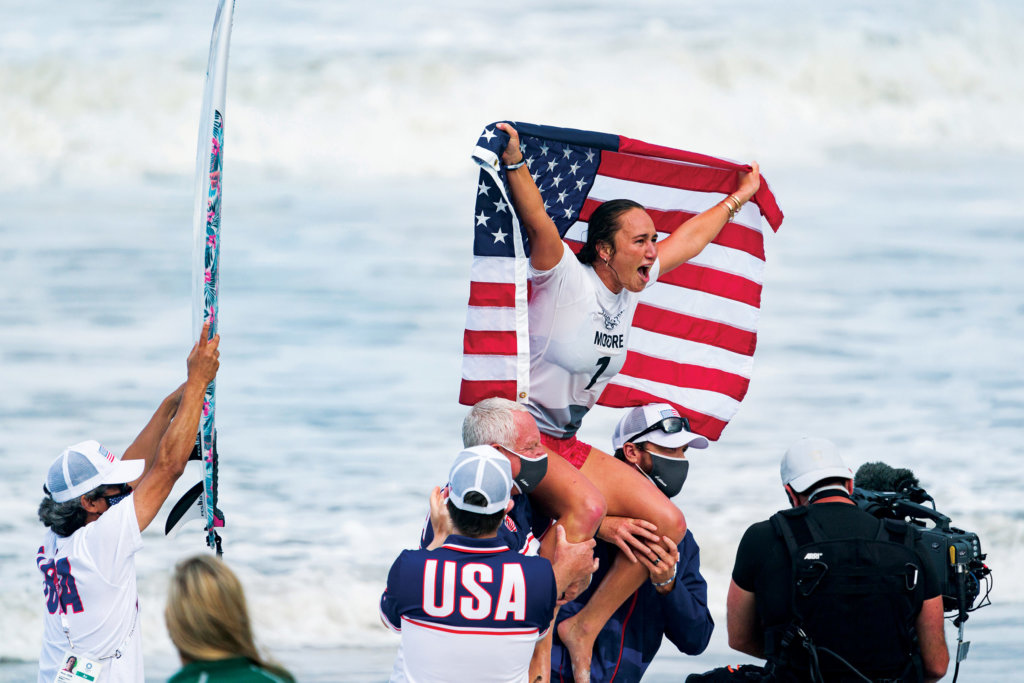
Carissa’s surfing career started at Waikīkī Beach, riding on the nose of her father’s board. By age 5, she was catching her own waves, and by 8, she was nailing flashy acrobatic moves. Her dad, a competitive collegiate swimmer, became her surfing coach. “So many kids in sports are homeschooled,” Chris says. “There was never a discussion about taking Carissa out of school. We always felt Carissa’s education was as important as what she was doing in the water.”
The pro surfer belongs to Punahou’s 13-plus club – students who’ve attended the School from kindergarten through graduation. Her favorite teacher, (Elaine) Higuchi Sensei, who taught her Japanese in middle school, was particularly demanding. “She never let her foot off the gas,” Carissa laughs. “But it was a great challenge. It pushed me.” Four years of Japanese paid off this year when Carissa arrived at the Olympic training camp in Japan and was able to give a speech on behalf of Team USA in their host country’s language.
Carissa credits her teachers’ flexibility for allowing her to chase her passion. “I definitely didn’t get any easy way out,” she says. “I was still held accountable for all the assignments.” She had to navigate a rigorous school schedule at Punahou and the regular pressures of teenage-hood, all while emerging as a wave-riding superstar. In 2008, at age 16, Carissa became the youngest person ever to win a Triple Crown event. Two years later, she qualified for professional surfing’s world tour.
Carissa started her senior year at Punahou as a rookie on the pro World Surf League (WSL) tour – no small amount of pressure. In the first few events of the TSB Bank Womens Surf Festival in New Zealand, she struggled to find her footing. Her dad suggested volunteering with a local surf club to give her a sense of community, so she contacted the Waitara Bar Boardriders Club, based on the mouth of the Waitara River. On the days she wasn’t competing, she hung out with local youngsters, surfed, shared meals and swapped stories. The kids came to cheer her on during contest heats. “That love really carried me through the event, because it wasn’t about the results anymore, I was surfing from my heart,” Carissa says.
She won the tournament, netted her first big purse and gave notice to the reigning champs that a new rider was in town. Surfer magazine called her victory “inevitable,” but expressed surprise when Carissa announced from the winner’s podium that she was donating her entire $15,000 prize to the Waitara Bar Boardriders Club. It was the first of her many gestures of aloha.
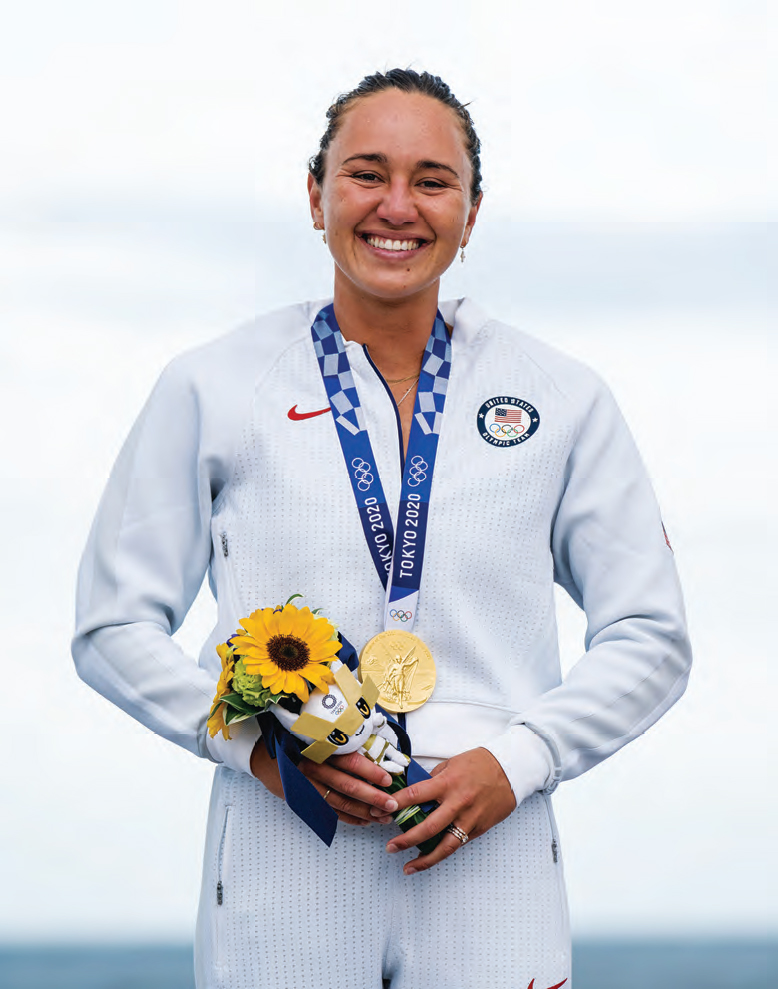
“Take music classes, take art classes, do sports, find out what you’re passionate about and what you love. It’s the time to make mistakes, to fall down and get back up, and to ask for help.”
Completing her senior year while competing internationally required sacrifices. Carissa faced a big choice when she learned that an important contest in Peru fell on the exact same day as graduation.
“My family was like, ‘Hey, you’ll have other championship tournaments, but this is your only time to graduate high school,’” she says. She skipped the contest and still ended up as WSL’s 2010 Rookie of the Year.
The very next year Carissa won the WSL championship – the youngest surfer ever to claim the title. From the start of her surfing career she has collected superlatives – youngest Triple Crown champion, first woman to qualify for the Men’s Triple Crown, biggest women’s purse ($50,000 at the 2010 US Open), and of course, first Olympic gold medalist surfer. National Geographic named her Adventurer of the Year in 2012, and in 2013, Glamour magazine called her a “game changer.” As 11-time world champion surfer Kelly Slater told Glamour, “She’s the best in the world right now. And what’s scary is, she just keeps improving.”
Slater was right. In the lead up to the Olympics, at the Newcastle Cup in Australia, Carissa landed a spectacular air reverse – a 360-degree spin in the air above the breaking wave. Stab magazine called it “an incredible leap for womenkind,” while WSL commentator Joe Turpel declared it a “defining moment in surfing history.”
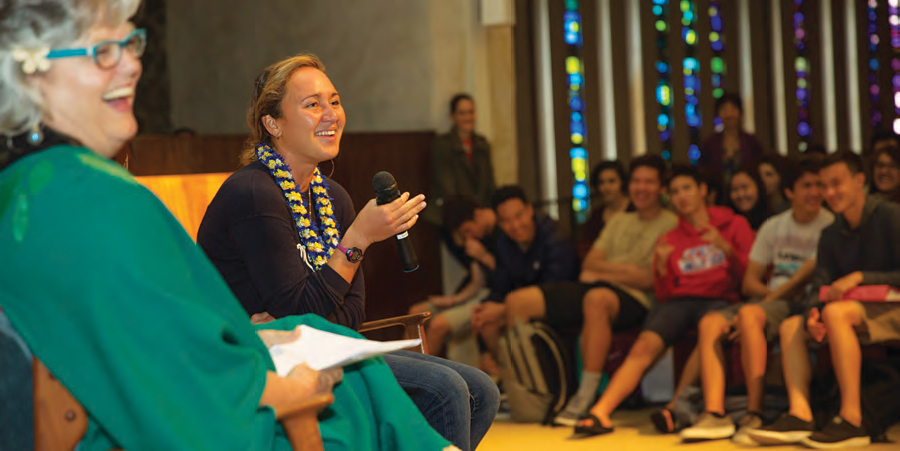
Carissa’s greatest accomplishment may be raising the profile of women’s surfing – a sport dominated in recent history by men. Carissa isn’t just staking her claim in this liquid landscape; she’s reinventing it. She presents a feminine, inclusive side to surfing. She’s close friends with her professional rivals (she and Buitendag hugged before exiting the beach after their Olympic match), blogs about body-image issues, and talks candidly about her dreams and prioritizing aloha in “Riss,” a documentary about her 2019 WSL tour.
At this moment in time, Carissa’s own biggest heroes are the pro athletes balancing their careers with new motherhood.
“Growing as a woman and looking towards the next stage of my life, I realize these women are strong, powerful and able to bring life to this world,” she says. “And they aren’t giving up on their dreams.”
All About Love
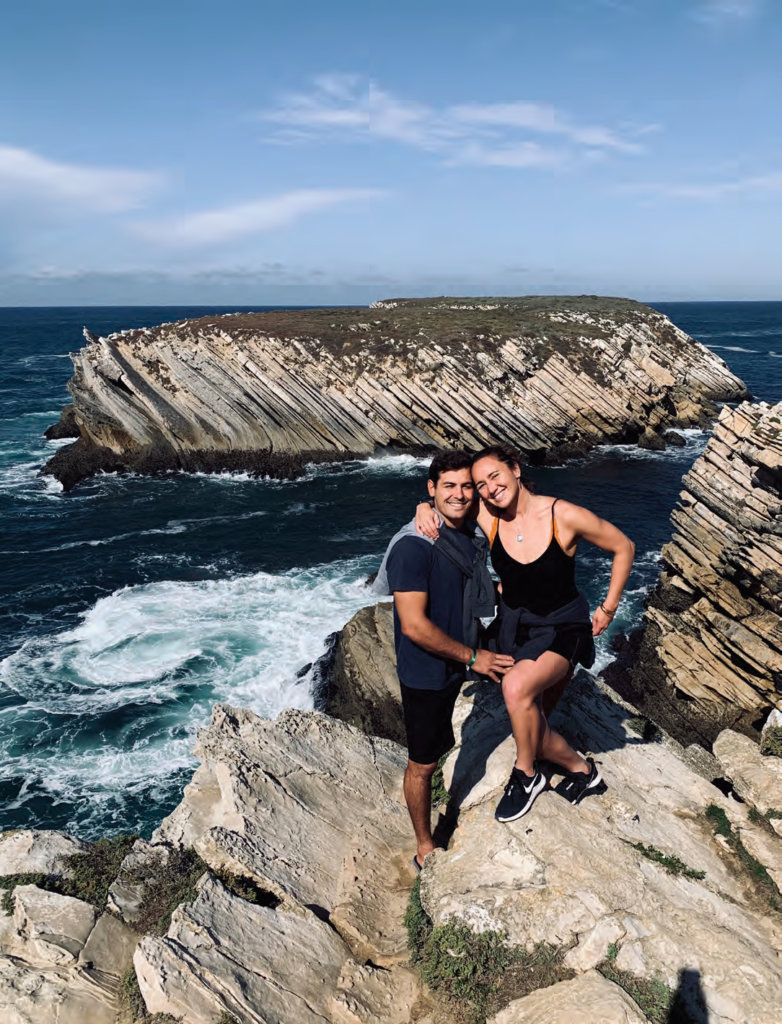
In her documentary, interviews and through her own platforms, Carissa attributes her professional success to an abundance of love.
She met her husband, Luke Untermann ’10, in the halls of Punahou’s Academy. She had a crush on the football player since their freshman year. “I would try to get to class extra early just so we could cross paths,” she recalls. But it wasn’t until senior year that their mutual best friends introduced them. “That was the beginning of the end – or the beginning of the beginning,” she laughs. When Carissa had to skip senior prom for a surf competition, he threw her a private prom on her porch. “It was just him and me and that was super special,” she says.
The couple have remained bonded ever since, supporting each other’s individual pursuits. After college, Untermann opened the O‘ahu-based dessert shop, Banán, with his childhood friends, Matt Hong ’10, Zak Barry ’10 and Galen McCleary ’10. Along with running Banán, he helps Carissa manage media and other requests. On her Instagram account, which has more than a half million followers, Carissa often posts about her joyous life on O‘ahu with her husband, friends and family. “Home makes my heart full. Family, friends, pups, sunshine, cake, naps and some salt water … all my favorite things,” she wrote on an Aug. 31 video post.
In 2017, Carissa returned to Punahou’s Chapel to speak about her journey from Punahou student to arguably the world’s greatest female surfer. “When I was 6, my dad would take me to the beach every day after school to tandem surf, play in the ocean, tumble around in the sand and build sandcastles,” she told students, teachers and parents who attended the event. “There were no grand schemes to win world titles or big goals to travel the world and be a professional surfer. At that point, it was just about having fun and doing something that I loved.”
Her advice to the next generation: Try everything. “Take music classes, take art classes, do sports,” she said. “Find out what you’re passionate about and what you love. It’s the time to make mistakes, to fall down and get back up, and to ask for help.”
Two years later, Carissa launched Moore Aloha, a nonprofit that uses surfing as a platform to bring young women together for confidence-building camps and beach cleanups. At her most recent camp held this past September in Oceanside, California, girls donned gorgeous lei po‘o after surf lessons. Guest coaches included Moore’s celebrity surfer friends: Slater, Lakey Peterson and Tatiana Weston-Webb, among others. “The goal is to empower young girls,” Carissa says, “and give them a safe space to grow outside their comfort zone and create friendships.”
Meanwhile, Hawai‘i’s newest gold medalist keeps racking up wins. Seven weeks after the Olympics, Carissa took first place in the WSL Rip Curl Finals, earning the world championship title for the fifth time.
Despite her stratospheric success, she keeps it real with her fans. After her latest victory, she shared the following on Instagram: “I had a few nerves in the first heat and an unexpected shaky start that threw me off a little … All the doubts came rushing back … and I was walking a fine line of falling into a negative, downward spiral. I am so grateful for my team and all the love that brought me back to peace … My husband looked at me with tears in his eyes and said, ‘Babe, if anyone can do this, you can.’ That love was strong enough to quiet any noise and remind me of what’s important. I know it may sound cheesy but it’s all about the love. So with some added flame to the fire and a whole lot of love, I went back out and surfed from my heart.”
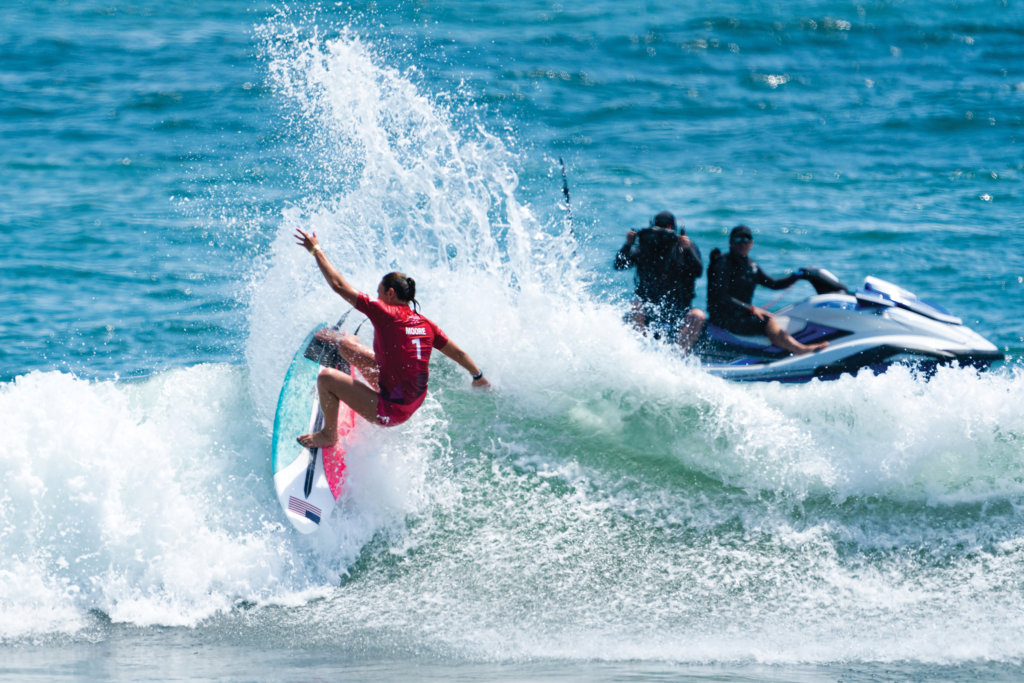
Photo from International Surfing Association.
